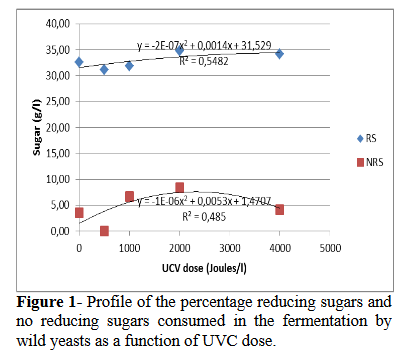Fermentation of sugar cane juice (Sacharum officinarum) cultivar RB 7515 by wild yeasts resistant to UVC
DOI:
https://doi.org/10.20873/jbb.uft.cemaf.v2n1.sobrinhoPalavras-chave:
Alcoholic fermentation, contamination control, water, dilution, Wild yeasts, UVC resistanceResumo
Fermentações alcoólicas comerciais convivem com contaminações por microrganismos presentes nos colmos de cana ou na água industrial. Os contaminantes são bactérias ou leveduras “selvagens” que resultam em prejuízosde rendimento. O controle destas contaminações é feito com ácido e antibiótico. A desinfecção por radiação ultravioleta é eficiente em líquidos transparentes e apresenta vantagem por não deixar resíduos. Relatos do efeito sobre microrganismos em líquidos turvos e coloridos são escassos. A pesquisa avaliou o uso de lâmpada comercial de radiação UVC para redução de carga microbiana e seu efeito sobre a fermentação do caldo de cana cultivar RB 7515. O caldo brutoe água usados na diluição a Brix 12,0 foram submetidos àsdoses de 0, 500, 1000, 2000 e 4000 Joules/l. As contagens foram feitas em meios de cultivo específicos. A dose 500 Joules/Lfoi suficiente para eliminar os coliformes, mas sobreviveram leveduras e bactérias mesófilas. Doses superiores a 500 Joules/leliminaram todos os microrganismos. O caldo tratado diluído a 12º Brix foi fermentado com a leveduras sobrevivente até estabilização do Brix, proporcionando vinho a 5°GLpara todos os tratamentos. Considerou-se que a potencialidade de leveduras selvagens resistentes àradiação UVCfoi comprovada.

Downloads
Publicado
Como Citar
Edição
Seção
Licença
Copyright (c) 2024 - Journal of Biotechnology and Biodiversity

Este obra está licenciado com uma Licença Creative Commons Atribuição 4.0 Internacional.
Autores que publicam nesta revista concordam com os seguintes termos:
Autores mantêm os direitos autorais e concedem à revista o direito de primeira publicação, com o trabalho simultaneamente licenciado sob a Licença Creative Commons Attribution (CC BY 4.0 no link http://creativecommons.org/licenses/by/4.0/) que permite o compartilhamento do trabalho com reconhecimento da autoria e publicação inicial nesta revista.
Autores têm autorização para assumir contratos adicionais separadamente, para distribuição não exclusiva da versão do trabalho publicada nesta revista (ex.: publicar em repositório institucional ou como capítulo de livro), com reconhecimento de autoria e publicação inicial nesta revista.
Autores têm permissão e são estimulados a publicar e distribuir seu trabalho online (ex.: em repositórios institucionais ou na sua página pessoal) a qualquer momento antes ou durante o processo editorial, já que isso pode gerar alterações produtivas, bem como aumentar o impacto e a citação do trabalho publicado (disponibilizado em O Efeito do Acesso Livre no link http://opcit.eprints.org/oacitation-biblio.html).


